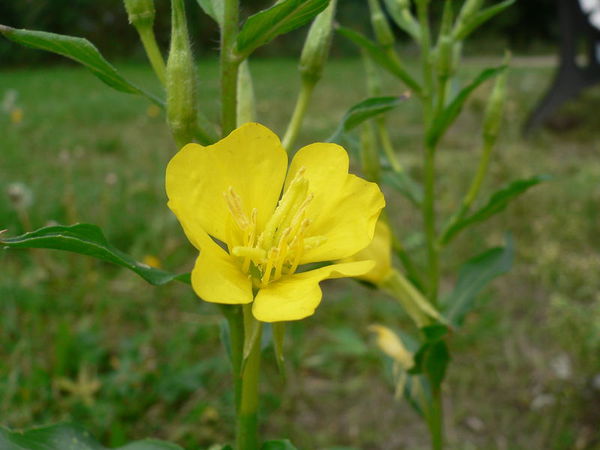
Common Name: Evening Primose | Scientific Name: Oenothera Biennis

Family Name: Ongagraceae
Introduction
Evening primrose was once used to treat all kinds of skin conditions, including those of newborns and infants. It was a real country cure and one that most people knew about and knew how to use. Today it has been entirely forgotten and is naught but a weed in the yard. But, its past suggests we should get to know this common plant.
Resources
Notes from the Eclectic Physicians
Notes from the Eclectic Physicians
1854. John King. Materia Medica. – OENOTHERA BIENNIS
Properties and Uses . – A strong decoction has been very beneficial in obstinate infantile eruptions, tetter, and some other cutaneous affections. Probably an oitment made by boiling the twigs, leaves and bark, in lard or tallow, would answer a similar purpose.
They must be gathered about the flowering season. In fomentation, or when recent, bruised, they form an excellent emollient in ulcers.
1895: Watkins: CEANOTHUS, SP MED:
Enlarged spleen, sallow skin, expressionless face. Ten drops to two drachms in four unces of water, teaspoonful very three hours.
1895: Watkins: OENOTHERA:
Catalepsy, sallow dirty skin, tissues and tongue; feeble innervation, insomnia, emotions easily excited with tendency to tears, diarrhoea, vomiting, and restlessness. Twenty to thirty drops of the tincture every four hours.
1898: Webster
This remedy has a high repute in some quarters in the treatment of the choleraic form of cholera infantum and in water diarrhoea.
It has also been used with remarkable success in dyspepsia, where there was vomiting of food, distress after eating, and restless nights, aggravated by a desire to urinate. However, this effect can only be expected where the symptoms arise from functional disturbance.
It has also been used in dysentery, where tenesmus was marked and considerable bloody mucus was discharged. In typhoid fever it has been found useful to allay irritation of the intestinal mucous membrane, and lessen the chances of serious mischief from the inflammatory action which precedes the ulceration of Peyer’s patches, while it is argued that it may prevent ulceration if its use be begun in time. In this it resembles baptisia and kaki.
Form for Administration- Parke, Davis & Co’s fluid extract.
DOSE- From ten to thirty drops.CENOTHERA BIENNIS
1898: Webster
This remedy has a high repute in some quarters in the treatment of the choleraic form of cholera infantum and in water diarrhoea.
It has also been used with remarkable success in dyspepsia, where there was vomiting of food, distress after eating, and restless nights, aggravated by a desire to urinate. However, this effect can only be expected where the symptoms arise from functional disturbance.
It has also been used in dysentery, where tenesmus was marked and considerable bloody mucus was discharged. In typhoid fever it has been found useful to allay irritation of the intestinal mucous membrane, and lessen the chances of serious mischief from the inflammatory action which precedes the ulceration of Peyer’s patches, while it is argued that it may prevent ulceration if its use be begun in time. In this it resembles baptisia and kaki.
Form for Administration- Parke, Davis & Co’s fluid extract.
DOSE- From ten to thirty drops
1898: Felter and Lloyd: OENOTHERA – EVENING PRIMROSE
Action, Medical Uses, and Dosage – An ointment made by boiling the twigs, leaves, and bark, in lard or tallow – or a strong decoction of these – has been found very efficient in curing tetter, milk-scall, and other cutaneous affections of infants. Collect the material when the plant is in flower. In fomentation, or when recent, the bruised leaves form an excellent application to ulcers. Internally, oenothera has been used for a number of purposes, and its specific field of action seems none too well established. It has, however, been accorded a place in the treatment of gastro-intestinal disorders of a functional character. Dr. Scudder points out as the indications for it, a sallow, dirty skin, with full and expressionless tissues, an expressionless face, an unnatural and large tongue, having the sallow, dirty hue of the skin, and the patient’s mentality is of a gloomy an ddespondent character. Under these conditions he has employed it with success in dyspepsia, hepatic torpor, splenic an dmesenteric glandular enlargements, and in female disorders, with torpor and pelvic fullness.
The dyspepsia met by it is that form associated with vomiting, distressing sensations after taking ood, restlessness at night, and frequent desire to pass urine. When cholera infantum and watery diarrhoeas assume a choleraic form, it has been asserted to act well, as it does in dysentery, with marked tenesmus and bloody stools. The intestinal irritation and consequent liability to destructive inflammation of Peyer’s patches, in enteric fever, is said to be lessened by the timely administration of oenothera (Webster). It relieves difficult respiration and chronic asthma, with gastric complication. The dose of the fluid extract ranges from 5 to 30 drops; of a strong tincture of the recent plant (98 per cent alcohol), from 1 to 15 drops.
Specific Indications and Uses – Sallow, dirty skin, tissues full and expressionless, tongue unnatural in size and color, being large and of the dirty color of the skin, face dull and apathetic; dyspepsia, with vomiting of food, and gastric distress, with desire to urinate frequently; choleraic and dysenteric discharges; nocturnal restlessness; innervation feeble; patient gloomy and despondent; atonic reproductive wrongs of the female, with pelvic fullness.
Disclaimer: The author makes no guarantees as to the the curative effect of any herb or tonic on this website, and no visitor should attempt to use any of the information herein provided as treatment for any illness, weakness, or disease without first consulting a physician or health care provider. Pregnant women should always consult first with a health care professional before taking any treatment.
